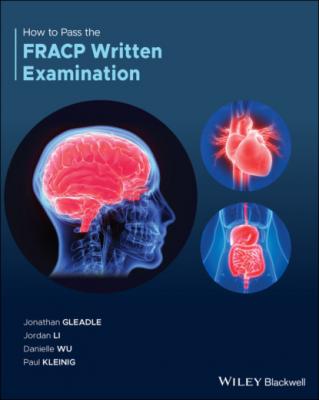How to Pass the FRACP Written Examination. Jonathan Gleadle
Читать онлайн.| Название | How to Pass the FRACP Written Examination |
|---|---|
| Автор произведения | Jonathan Gleadle |
| Жанр | Медицина |
| Серия | |
| Издательство | Медицина |
| Год выпуска | 0 |
| isbn | 9781119599548 |
According to the 2018 Australian and New Zealand Council of Resuscitation (ANZCOR) Advanced Life Support Guideline, intravenous amiodarone (300 mg) should be administered after the third failed attempt at defibrillation, at the time of recommencement of CPR. There is no evidence that giving any antiarrhythmic drug routinely during cardiac arrest increases rate of survival to hospital discharge. However, in comparison with placebo and lignocaine the use of amiodarone in shock‐refractory VF improves the short‐term survival. Despite the lack of long‐term outcome data, it is reasonable to continue to use antiarrhythmic drugs on a routine basis.
Magnesium sulphate is indicated only in the treatment of VF or pulseless VT arrest due to drug induced prolonged QT interval associated with torsades de pointes.
There are no placebo‐controlled studies that show that the routine use of any vasopressor at any stage during cardiac arrest increases survival to hospital discharge, though they have been demonstrated to increase return of spontaneous circulation. Current evidence is insufficient to support or refute the routine use of any particular drug or sequence of drugs. Despite the lack of human data, it is reasonable to continue to use vasopressors on a routine basis. Adrenaline (1 mg), when indicated, should be administered after rhythm analysis (± shock), at the time of recommencement of CPR.
Guidelines [Internet]. Resus.org.au. 2019 [cited 24 March 2019]. Available from: https://resus.org.au/guidelines/
24. Answer: D
This patient is in septic shock, likely due to urosepsis. Sepsis and septic shock are medical emergencies and treatment and resuscitation should begin immediately. Latest guidelines dictate that following initial fluid resuscitation, administration of additional fluids should be guided by frequent assessment of haemodynamic status. This includes thorough clinical examination including blood pressure, heart rate, respiratory rate, temperature, oxygen saturation and urine output. This patient is responding to initial fluid resuscitation; therefore, it is appropriate to continue monitor blood pressure and urine output and give additional fluid.
New evidence found that the use of CVP alone to guide fluid resuscitation can no longer be justified given the limited ability of CVP to predict a response to a fluid challenge when the CVP is within a relatively normal range (8–12 mmHg).
Recommended volume of fluid resuscitation starts at 30mL/kg; however, the balance of additional fluids and the use of vasopressors remains uncertain. Several clinical trials are underway which will evaluate this, however currently the goal of fluid resuscitation should be targeted at a mean arterial pressure (MAP) of 65mmHg through the use of fluids and vasopressors, while normalising the lactate level.
In summary:
‐ Septic shock is a medical emergency and resuscitation should begin immediately.
‐ Initial fluid volume administered should start at 30 mL/kg.
‐ Further fluid administration should be based on haemodynamic status as determined by physiologic parameters (blood pressure, heart rate, urine output, oxygen saturation and temperature).
‐ A target MAP of 65mmHg may be used for vasopressor and fluid adjustment.
‐ Serial measurement of CVP, Scvo2 and haemoglobin using a CVC is no longer recommended.
Berger R, Rivers E, Levy M. Management of Septic Shock. New England Journal of Medicine. 2017;376(23):2282–2285.https://www.nejm.org/doi/full/10.1056/NEJMclde1705277
Rhodes A, Evans L, Alhazzani W, Levy M, Antonelli M, Ferrer R et al. Surviving Sepsis Campaign: International Guidelines for Management of Sepsis and Septic Shock: 2016. Intensive Care Medicine. 2017;43(3):304–377.
https://link.springer.com/article/10.1007%2Fs00134‐017‐4683‐6
25. Answer: B
The latest guidelines from the Surviving Sepsis Campaign give detailed recommendations of initial resuscitation, screening and diagnosis of sepsis, antibiotic therapy, fluid administration, source control, administration of vasopressors and steroids, blood products, anticoagulants, immunoglobulins, mechanical ventilation, sedation, analgesia, glucose control, blood purification, renal replacement therapy, bicarbonate, venous thromboembolism and stress ulcer prophylaxis, and nutrition.
Specific recommendations in antimicrobial treatment include:
Administration of IV antimicrobials be initiated as soon as possible after recognition, and within one hour for both sepsis and septic shock.
Empiric broad‐spectrum therapy with one or more antimicrobials for patients presenting with sepsis or septic shock to cover all likely pathogens (including bacterial and potentially fungal or viral coverage) should be used initially.
Empiric antimicrobial therapy be narrowed once pathogen identification and sensitivities are established and/or adequate clinical improvement is noted.
Daily assessment for de‐escalation of antimicrobial therapy in patients with sepsis and septic shock should be performed.
Do not use systemic antimicrobial prophylaxis in patients with severe inflammatory states of non‐infectious origin such as severe pancreatitis, burn injury.
Dosing strategies of antimicrobials should be optimised based on accepted pharmacokinetic/pharmacodynamic principles and specific drug properties in patients with sepsis or septic shock.
Do not use combination therapy for the routine treatment of neutropenic sepsis/bacteraemia.
An antimicrobial treatment duration of 7 to 10 days is adequate for most serious infections associated with sepsis and septic shock.
Rhodes A, Evans L, Alhazzani W, Levy M, Antonelli M, Ferrer R et al. Surviving Sepsis Campaign. Critical Care Medicine [Internet]. 2017 [cited 21 June 2020];45(3):486–552. Available from: https://journals.lww.com/ccmjournal/Fulltext/2017/03000/Surviving_Sepsis_Campaign___International.15.aspx
26. Answer: E
27. Answer: B
28. Answer: D
29. Answer: F
30. Answer: A
31. Answer: G
Inotropes and vasopressors are used in shock states to improve perfusion by increasing BP. As BP is a function of both cardiac output and systemic vascular resistance, medications can increase BP by either increasing one or both of these parameters. Vasopressors induce vasoconstriction and thereby elevate BP. Inotropes increase cardiac contractility; however, many drugs have both vasopressor and inotropic effects.
One of the key mechanisms by which medications can improve BP is by stimulation of adrenoreceptors. Dobutamine predominantly stimulates beta adrenoreceptors
